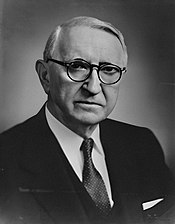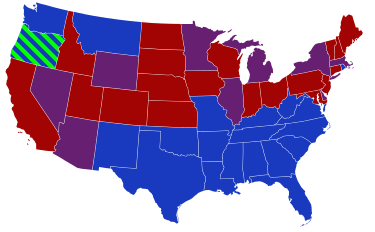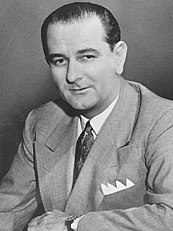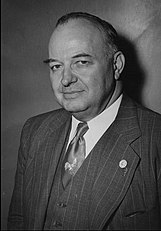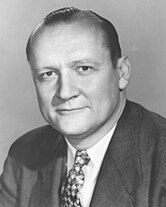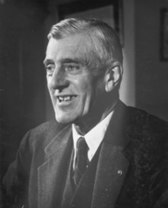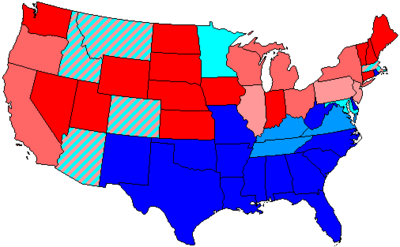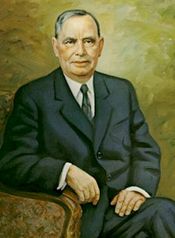
The 82nd United States Congress was a meeting of the legislative branch of the United States federal government, composed of the United States Senate and the United States House of Representatives. It met in Washington, D.C., from January 3, 1951, to January 3, 1953, during the last two years of President Harry S. Truman's second term in office.

The 107th United States Congress was a meeting of the legislative branch of the United States federal government, composed of the United States Senate and the United States House of Representatives. It met in Washington, D.C., from January 3, 2001, to January 3, 2003, during the final weeks of the Clinton presidency and the first two years of the George W. Bush presidency. The apportionment of seats in this House of Representatives was based on the 1990 United States census.

The 104th United States Congress was a meeting of the legislative branch of the United States federal government, composed of the United States Senate and the United States House of Representatives. It met in Washington, D.C. from January 3, 1995, to January 3, 1997, during the third and fourth years of Bill Clinton's presidency. Apportionment of seats in the House of Representatives was based on the 1990 United States census.

The 101st United States Congress was a meeting of the legislative branch of the United States federal government, composed of the United States Senate and the United States House of Representatives. It met in Washington, D.C., from January 3, 1989, to January 3, 1991, during the final weeks of Ronald Reagan's presidency and the first two years of George H. W. Bush's presidency.

The 95th United States Congress was a meeting of the legislative branch of the United States federal government, composed of the United States Senate and the United States House of Representatives. It met in Washington, D.C., from January 3, 1977, to January 3, 1979, during the final weeks of Gerald Ford's presidency and the first two years of Jimmy Carter's presidency.

The 92nd United States Congress was a meeting of the legislative branch of the United States federal government, composed of the United States Senate and the United States House of Representatives. It met in Washington, D.C., from January 3, 1971, to January 3, 1973, during the third and fourth years of Richard Nixon's presidency.

The 91st United States Congress was a meeting of the legislative branch of the United States federal government, composed of the United States Senate and the United States House of Representatives. It met in Washington, D.C., from January 3, 1969, to January 3, 1971, during the final weeks of the presidency of Lyndon Johnson and the first two years of the first presidency of Richard Nixon.

The 85th United States Congress was a meeting of the legislative branch of the United States federal government, composed of the United States Senate and the United States House of Representatives. It met in Washington, D.C. from January 3, 1957, to January 3, 1959, during the fifth and sixth years of Dwight Eisenhower's presidency. The apportionment of seats in the House of Representatives was based on the 1950 United States census.

The 83rd United States Congress was a meeting of the legislative branch of the federal government of the United States in Washington, D.C. from January 3, 1953, until January 3, 1955, during the last two weeks of the Truman administration, with the remainder spanning the first two years of Dwight Eisenhower's presidency. It was composed of the Senate and the House of Representatives. The apportionment of seats in the House was based on the 1950 U.S. census.

The 90th United States Congress was a meeting of the legislative branch of the United States federal government, composed of the United States Senate and the United States House of Representatives. It met in Washington, D.C., from January 3, 1967, to January 3, 1969, during the last two years of President Lyndon B. Johnson's second term in office.

The 81st United States Congress was a meeting of the legislative branch of the United States federal government, composed of the United States Senate and the United States House of Representatives. It met in Washington, D.C. from January 3, 1949, to January 3, 1951, during the fifth and sixth years of Harry S. Truman's presidency.

The 80th United States Congress was a meeting of the legislative branch of the United States federal government, composed of the United States Senate and the United States House of Representatives. It met in Washington, D.C. from January 3, 1947, to January 3, 1949, during the third and fourth years of Harry S. Truman's presidency. The apportionment of seats in this House of Representatives was based on the 1940 United States census.

The 87th United States Congress was a meeting of the legislative branch of the United States federal government, composed of the United States Senate and the United States House of Representatives. It met in Washington, D.C. from January 3, 1961, to January 3, 1963, during the final weeks of Dwight D. Eisenhower's presidency and the first two years of John Kennedy's presidency. The apportionment of seats in the House of Representatives was based on the 1950 United States census, along with two seats temporarily added in 1959.

The 89th United States Congress was a meeting of the legislative branch of the United States federal government, composed of the United States Senate and the United States House of Representatives. It met in Washington, D.C., from January 3, 1965, to January 3, 1967, during the second and third years of Lyndon B. Johnson's presidency. The apportionment of seats in the House of Representatives was based on the 1960 United States census.

The 77th United States Congress was a meeting of the legislative branch of the United States federal government, composed of the United States Senate and the United States House of Representatives. It met in Washington, D.C., from January 3, 1941, to December 16, 1942, during the ninth and tenth years of Franklin D. Roosevelt's presidency. The apportionment of seats in the House of Representatives was based on the 1930 United States census.

The 88th United States Congress was a meeting of the legislative branch of the United States federal government, composed of the United States Senate and the United States House of Representatives. It met in Washington, D.C., from January 3, 1963, to January 3, 1965, during the final months of the presidency of John F. Kennedy, and the first years of the presidency of his successor, Lyndon B. Johnson. The apportionment of seats in this House of Representatives was based on the 1960 United States census, and the number of members was again 435.

The 79th United States Congress was a meeting of the legislative branch of the United States federal government, composed of the United States Senate and the United States House of Representatives. It met in Washington, D.C., from January 3, 1945, to January 3, 1947, during the last months of Franklin D. Roosevelt's presidency, and the first two years of Harry Truman's presidency. The apportionment of seats in this House of Representatives was based on the 1940 United States census.

The 78th United States Congress was a meeting of the legislative branch of the United States federal government, composed of the United States Senate and the United States House of Representatives. It met in Washington, D.C., from January 3, 1943, to January 3, 1945, during the last two years of Franklin D. Roosevelt's presidency. The apportionment of seats in the House of Representatives was based on the 1940 United States census.

The 86th United States Congress was a meeting of the legislative branch of the United States federal government, composed of the United States Senate and the United States House of Representatives. It met in Washington, D.C. from January 3, 1959, to January 3, 1961, during the last two years of the presidency of Dwight D. Eisenhower.

The 112th United States Congress was a meeting of the legislative branch of the United States federal government, from January 3, 2011, until January 3, 2013. It convened in Washington, D.C., on January 3, 2011, and ended on January 3, 2013, 17 days before the end of the presidential term to which Barack Obama was elected in 2008. Senators elected to regular terms in 2006 completed those terms in this Congress. This Congress included the last House of Representatives elected from congressional districts that were apportioned based on the 2000 census.


